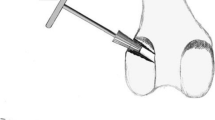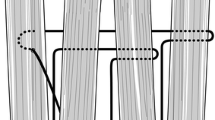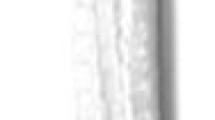Abstract
Introduction
Double-bundle reconstruction of the ACL has become the focus of scientific and clinical interest in the last years. However, there is still a discussion about the most appropriate technique for graft fixation. Both, extracortical fixation systems like the Endobutton and aperture fixation by interference screws have advantages as well as disadvantages. Aim of this study was to analyze the biomechanical properties of a new small wedge shaped implant (MiniShim, Karl Storz, Germany) for the fixation of a soft tissue graft in double bundle ACL reconstruction and to compare it to an aperture fixation by interference screw and an extracortical fixation.
Methods
Porcine knees and flexor tendons were used for this study. 5 and 6 mm tunnels were drilled. The following fixation strategies were tested: 4 and 5 mm MiniShim (Karl Storz Germany), 6 mm interference screw (MegaFix, Karl Storz, Germany), hybridfixation by FlippTack (FlippTack, Karl Storz, Germany) and MiniShim and hybridfixation by FlippTack and 6 mm interference screw. All fixation strategies were tested with a 5 and 6 mm tendon graft. Maximum load, yield load and stiffness were recorded using a material testing machine. Load was applied in line with the bone tunnel. Grafts were cyclically preconditioned between 0 and 20 N for 10 cycles before the graft–bone-complex was loaded to failure. Statistical evaluation was performed using SPSS Version 11.0.
Results
Load to failure for the 5 mm graft was 81.1 and 118.0 N for the 4 and 5 mm MiniShims. Fixation by interference screw reached 237.4 N. The extracortical fixation resulted in a load to failure of 471.7 N. Load to failure for the 6 mm tendon grafts was 52.0 and 92.8 N for the 4 and 5 mm MiniShims. Fixation by interference screw resulted in a load to failure of 214.0 N. Extracortical fixation failed at 451.7 N. The difference between MiniShim and interference screw was statistically significant. Load to failure was significantly higher for extracortical fixation compared to fixation by MiniShim or interference screw. Hybrid fixation showed higher fixation strength compared to fixation by interference screw or MiniShim alone. This difference was statistically significant. Stiffness was significantly higher for fixation by interference screw compared to extracortical fixation and fixation by MiniShim. Four different modes of failure could be seen. All 4 mm MiniShims failed by slippage of the tendon past the MiniShim. In the 5 mm group the fixation failed by pullout of the MiniShim or the tendon past the MiniShim. Hybrid fixation failed by rupture of the linkage material. When the graft was fixed by an interference screw failure occurred by rupture of the tendon at the fixation side.
Conclusion
Hybrid fixation using the MiniShim provides biomechanical properties strong enough to withstand the forces occurring during rehabilitation and comparable to the fixation strength provided by interference screw. While fixation by MiniShim alone does not provide sufficient fixation strength in double bundle ACL reconstruction, hybridfixation using a cortical fixation by FlippTack is an alternative to aperture fixation by interference screw concerning primary stability.





Similar content being viewed by others
References
Aglietti P, Giron F, Cuomo P, Losco M, Mondanelli N (2007) Single-and double-incision double-bundle ACL reconstruction. Clin Orthop Relat Res 454:108–113
Beynnon BD, Johnson RJ, Abate JA, Fleming BC, Nichols CE (2005) Treatment of anterior cruciate ligament injuries, part 2. Am J Sports Med 33(11):1751–1767
Beynnon BD, Johnson RJ, Abate JA, Fleming BC, Nichols CE (2005) Treatment of anterior cruciate ligament injuries, part I. Am J Sports Med 33(10):1579–1602
Beynnon BD, Uh BS, Johnson RJ et al (2005) Rehabilitation after anterior cruciate ligament reconstruction: a prospective, randomized, double-blind comparison of programs administered over 2 different time intervals. Am J Sports Med 33(3):347–359
Brand J Jr, Weiler A, Caborn DN, Brown CH Jr, Johnson DL (2000) Graft fixation in cruciate ligament reconstruction. Am J Sports Med 28(5):761–774
Brown GA, Pena F, Grontvedt T, Labadie D, Engebretsen L (1996) Fixation strength of interference screw fixation in bovine, young human, and elderly human cadaver knees: influence of insertion torque, tunnel-bone block gap, and interference. Knee Surg Sports Traumatol Arthrosc 3(4):238–244
Daniel DM, Stone ML, Dobson BE, Fithian DC, Rossman DJ, Kaufman KR (1994) Fate of the ACL-injured patient. A prospective outcome study. Am J Sports Med 22(5):632–644
Ferrari JD, BachB (2001) Isolated anterior cruciate ligament injury. In: Chapman MW (ed) Chap-man’s orthopedic surgery.Lippincott, Williams & Wilkins, Philadelphia
Franceschi JP, Sbihi A, Champsaur P (2002) Arthroscopic reconstruction of the anterior cruciate ligament using double anteromedial and posterolateral bundles. Rev Chir Orthop Reparatrice Appar Mot 88(7):691–697
Frank CB, Jackson DW (1997) The science of reconstruction of the anterior cruciate ligament. J Bone Joint Surg Am 79(10):1556–1576
Giurea M, Zorilla P, Amis AA, Aichroth P (1999) Comparative pull-out and cyclic-loading strength tests of anchorage of hamstring tendon grafts in anterior cruciate ligament reconstruction. Am J Sports Med 27(5):621–625
Holden JP, Grood ES, Korvick DL, Cummings JF, Butler DL, Bylski-Austrow DI (1994) In vivo forces in the anterior cruciate ligament: direct measurements during walking and trotting in a quadruped. J Biomech 27(5):517–526
Hulstyn M, Fadale PD, Abate J, Walsh WR (1993) Biomechanical evaluation of interference screw fixation in a bovine patellar bone-tendon-bone autograft complex for anterior cruciate ligament reconstruction. Arthroscopy 9(4):417–424
Kondo E, Yasuda K, Azuma H, Tanabe Y, Yagi T (2008) Prospective clinical comparisons of anatomic double-bundle versus single-bundle anterior cruciate ligament reconstruction procedures in 328 consecutive patients. Am J Sports Med 36(9):1675–1687
Kurosaka M, Yoshiya S, Andrish JT (1987) A biomechanical comparison of different surgical techniques of graft fixation in anterior cruciate ligament reconstruction. Am J Sports Med 15(3):225–229
Lehmann AK, Osada N, Zantop T, Raschke MJ, Petersen W (2009) Femoral bridge stability in double-bundle ACL reconstruction: impact of bridge width and different fixation techniques on the structural properties of the graft/femur complex. Arch Orthop Trauma Surg 129(8):1127–1132
Lenschow S, Herbort M, Strasser A et al (2011) Structural properties of a new device for graft fixation in cruciate ligament reconstruction: the shim technique. Arch Orthop Trauma Surg
Liu SH, Kabo JM, Osti L (1995) Biomechanics of two types of bone-tendon-bone graft for ACL reconstruction. J Bone Joint Surg Br 77(2):232–235
Marcacci M, Molgora AP, Zaffagnini S, Vascellari A, Iacono F, Presti ML (2003) Anatomic double-bundle anterior cruciate ligament reconstruction with hamstrings. Arthroscopy 19(5):540–546
Muneta T, Koga H, Morito T, Yagishita K, Sekiya I (2006) A retrospective study of the midterm outcome of two-bundle anterior cruciate ligament reconstruction using quadrupled semitendinosus tendon in comparison with one-bundle reconstruction. Arthroscopy 22(3):252–258
Petersen W, Zantop T (2007) Anatomy of the anterior cruciate ligament with regard to its two bundles. Clin Orthop Relat Res 454:35–47
Petersen W, Zantop T (2009) Das vordere Kreuzband.Deutscher Ärzteverlag, Heidelberg
Shelbourne KD, Patel DV (1996) Rehabilitation after autogenous bone-patellar tendon-bone ACL reconstruction. Instr Course Lect 45:263–273
Siebold R, Dehler C, Ellert T (2008) Prospective randomized comparison of double-bundle versus single-bundle anterior cruciate ligament reconstruction. Arthroscopy 24(2):137–145
Singhatat W, Lawhorn KW, Howell SM, Hull ML (2002) How four weeks of implantation affect the strength and stiffness of a tendon graft in a bone tunnel: a study of two fixation devices in an extraarticular model in ovine. Am J Sports Med 30(4):506–513
Strobel MJ, Zantop T (2010) Vorderes Kreuzband. Endopress, Tuttlingen
Weiler A, Peine R, Pashmineh-Azar A, Abel C, Sudkamp NP, Hoffmann RF (2002) Tendon healing in a bone tunnel. Part I: Biomechanical results after biodegradable interference fit fixation in a model of anterior cruciate ligament reconstruction in sheep. Arthroscopy 18(2):113–123
Yagi M, Kuroda R, Nagamune K, Yoshiya S, Kurosaka M (2007) Double-bundle ACL reconstruction can improve rotational stability. Clin Orthop Relat Res 454:100–107
Yagi M, Wong EK, Kanamori A, Debski RE, Fu FH, Woo SL (2002) Biomechanical analysis of an anatomic anterior cruciate ligament reconstruction. Am J Sports Med 30(5):660–666
Yasuda K, Kondo E, Ichiyama H et al (2004) Anatomic reconstruction of the anteromedial and posterolateral bundles of the anterior cruciate ligament using hamstring tendon grafts. Arthroscopy 20(10):1015–1025
Yasuda K, Kondo E, Ichiyama H, Tanabe Y, Tohyama H (2006) Clinical evaluation of anatomic double-bundle anterior cruciate ligament reconstruction procedure using hamstring tendon grafts: comparisons among 3 different procedures. Arthroscopy 22(3):240–251
Zantop T, Kubo S, Petersen W, Musahl V, Fu FH (2007) Current techniques in anatomic anterior cruciate ligament reconstruction. Arthroscopy 23(9):938–947
Zantop T, Petersen W, Sekiya JK, Musahl V, Fu FH (2006) Anterior cruciate ligament anatomy and function relating to anatomical reconstruction. Knee Surg Sports Traumatol Arthrosc 14(10):982–992
Zantop T, Weimann A, Schmidtko R, Herbort M, Raschke MJ, Petersen W (2006) Graft laceration and pullout strength of soft-tissue anterior cruciate ligament reconstruction: in vitro study comparing titanium, poly-d, l-lactide, and poly-d, l-lactide-tricalcium phosphate screws. Arthroscopy 22(11):1204–1210
Acknowledgments
This study was financially supported by Karl Storz, Tuttlingen, Germany
Author information
Authors and Affiliations
Corresponding author
Rights and permissions
About this article
Cite this article
Lenschow, S., Schliemann, B., Dressler, K. et al. Structural properties of a new fixation strategy in double bundle ACL reconstruction: the MiniShim. Arch Orthop Trauma Surg 131, 1159–1165 (2011). https://doi.org/10.1007/s00402-011-1331-4
Received:
Published:
Issue Date:
DOI: https://doi.org/10.1007/s00402-011-1331-4




